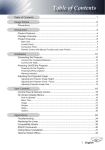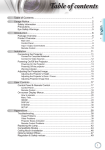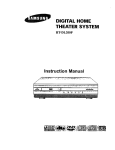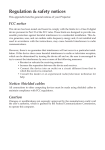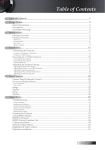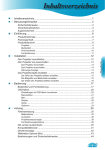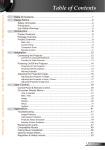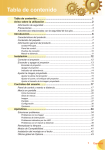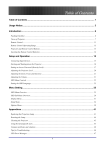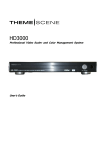Download User Controls
Transcript
Table of contents Safety Information .........................................................................................2 Precautions ...................................................................................................3 Eye Safety Warnings .....................................................................................5 Introduction ............................................................................................ 6 Product Features ...........................................................................................6 Package Overview ........................................................................................7 Product Overview ..........................................................................................8 Main Unit ................................................................................................................ 8 Control Panel ......................................................................................................... 9 Connection Ports ................................................................................................. 10 Remote Control .................................................................................................... 11 Installation ............................................................................................ 12 Connecting the Projector .............................................................................12 Powering On/Off the Projector ....................................................................13 Powering On the Projector ................................................................................... 13 Powering Off the projector ................................................................................... 14 Warning Indicator ................................................................................................. 14 Adjusting the Projected Image ....................................................................15 Adjusting the Projector’s Height ........................................................................... 15 Adjusting the Projector’s Zoom / Focus ............................................................... 16 Adjusting Projected Image Size ........................................................................... 16 User Controls ....................................................................................... 17 Control Panel & Remote Control .................................................................17 On-screen Display Menus ...........................................................................20 How to operate .................................................................................................... 20 Menu Tree ............................................................................................................ 21 Image ................................................................................................................... 22 Display ................................................................................................................ 28 Setup.................................................................................................................... 31 Options................................................................................................................. 33 Appendices .......................................................................................... 35 Troubleshooting ...........................................................................................35 Image Problems .................................................................................................. 35 Intermission Problems ........................................................................................ 37 Projector Status Indication .................................................................................. 38 Remote Control Problems ................................................................................... 39 Replacing the Lamp ....................................................................................40 Compatibility Modes ....................................................................................41 Ceiling Mount Installation ............................................................................42 Optoma Global Office ..................................................................................43 Regulation & Safety notices ........................................................................44 1 English Table of Contents ................................................................................... 1 Usage Notice .......................................................................................... 2 Usage Notice Safety Information The lightning flash with arrowheard within an equilateral triangle is intended to alert the user to the presence of uninsulated “dangerous voltage” within the product’s enclosure that may be of sufficient magnitude to constitute a risk of electric shock to persons. The exclamation point within an equilateral triangle is intended to alert the user to the presence of import operating and maintenance (servicing) instructions in the literature accompanying the appliance. WARNING: TO REDUCE THE RISK OF FIRE OR ELECTRIC SHOCK, DO NOT EXPOSE THIS APPLIANCE TO RAIN OR MOISTURE. DANGEROUS HIGH VOLTAGES ARE PRESENT INSIDE THE ENCLOSURE. DO NOT OPEN THE CABINET. REFER SERVICING TO QUALIFIED PERSONNEL ONLY. Class B emissions limits This Class B digital apparatus meets all requirements of the Canadian Interference-Causing Equipment Regulations. Important Safety Instruction 1. 2. 3. 4. 5. 6. 7. 8. 9. 10. 2 Read these instructions –before using this projector. Keep these instructions –for future reference. Follow all instructions. Install in accordance with the manufacturer’s instructions A. Do not block any ventilation openings To ensure reliable operation of the projector and to protect it from overheating, put the projector in a position and location that will not interfere with its proper ventilation. For example, do not place the projector on a bed, sofa, carpet, or similar surface that may block the ventilation openings. Do not put it in an enclosure, such as a bookcase or a cabinet that may keep air from flowing through its ventilation openings. B. Do not use this projector near water or moisture. To reduce the risk of fire or electric shock, do not expose the projector to rain or moisture. C. Do not install near any heat sources, such as radiators, heaters, stoves or other apparatus (including amplifiers) that produce heat. Clean only with a dry cloth. Only use attachments/accessories specified by the manufacturer. Refer all servicing to qualified service personnel. Servicing is required when the projector has been damaged in any way: ▀■ Such as power supply cord or plug is damaged. ▀■ Liquid has been spilled or objects have fallen into the apparatus. ▀■ The projector has been exposed to rain or moisture, does not operate normally, or has been dropped. Do not attempt to service this projector yourself. Opening or removing covers may expose you to dangerous voltages or other hazards. Please call Optoma to be referred to an authorized service center near you. Do not let objects or liquids enter the projector –as they may touch dangerous voltage points or short-out parts that could result in a fire or electric shock. See projector enclosure for safety related markings. The projector should not be adjusted or repaired by anyone except properly qualified service personnel. Usage Notice Please follow all warnings, precautions and maintenance as recommended in this user’s guide. ▀■ Warning- Do not look into the projector’s lens when the lamp is on. The bright light may hurt your eyes. ▀■ Warning- To reduce the risk of fire or electric shock, do not expose this projector to rain or moisture. ▀■ Warning- Please do not open or disassemble the projector as this may cause electric shock. ▀■ Warning- When replacing the lamp, please allow unit to cool down, and follow all replacement instructions. See page 40. ▀■ Warning- This projector will detect the life of the lamp itself. Please be sure to change the lamp when it shows warning messages. ▀■ Warning- Reset the “Lamp Reset” function from the on-screen display “Options|Lamp Settings” menu after replacing the lamp module (refer to page 34). ▀■ Warning- When switching the projector off, please ensure the cooling cycle has been completed before disconnecting power. Allow 90 seconds for the projector to cool down. ▀■ Warning- Do not use lens cap when projector is in operation. When the lamp reaches the end of its life, the projector will not turn back on until the lamp module has been replaced. To replace the lamp, follow the procedures listed under “Replacing the Lamp” section on page 40. ▀■ Warning- When the lamp is approaching to the end of its life time, the message “Replacement suggested” will show on the screen. Please contact your local reseller or service center to change the lamp as soon as possible. 3 English Precautions Usage Notice Do: Turn off the product before cleaning. Use a soft cloth moistened with mild detergent to clean the display housing. Disconnect the power plug from AC outlet if the product is not being used for a long period of time. Don’t: Block the ventilation slots and openings on the unit. Use abrasive cleaners, waxes or solvents to clean the unit. Use under the following conditions: - In extremely hot, cold or humid environments. - In areas susceptible to excessive dust and dirt. - Near any appliance that generates a strong magnetic field. - In direct sunlight. 4 Usage Notice English Eye Safety Warnings ▀■ Avoid staring directly into the projector beam at all times. ▀■ Minimize standing facing into the beam. Keep your back to the beam as much as possible. ▀■ A stick or laser pointer is recommended to avoid the need for the user to enter the beam. ▀■ Ensure that projectors are located out of the line of sight from the screen to the audience; this ensures that, when presenters look at the audience, they do not also have to stare at the projector lamp. The best way to achieve this is by ceiling-mounting rather than floor or table-mounting the projector. ▀■ When projector is used in a classroom, adequately supervise students when they are asked to point out something on the screen. ▀■ In order to minimize the lamp power needed, use room blinds to reduce ambient light levels. 5 Introduction Product Features This product is an WXGA single chip 0.65” DLP® projector. Outstanding features include: Single 16:9 1280 x 768 Dark Chip3TM DLP® technology Dual resolution support: -16:10 (1280 x 768) -16:9 (1280 x 720) native for 720P HDTV capability 6 segment GRBGRB colour wheel 480i - NTSC/NTSC4.43 576i - PAL/PAL-M/PAL-N/SECAM HDTV compatible (480p, 576p, 720p, 1080i) Deinterlacer Faroudja DCDi® Full function IR remote control with back light Advanced 2D digital keystone correction and high quality full screen image re-scaling User friendly control panel SXGA+, SXGA compression and HD, XGA, SVGA, VGA re-sizing Optoma’s patent-pending O2AirTM Photo Catalyst air purification technology HDMI & DVI support with HDCP compliance True Vivid and Brilliant ColorTM Image technology 16:10 / 16:9, integrate with complete image function: Format, Overscan, Digital Image Shift construction (Vertical/Horizontal) 6 Introduction Package Overview Due to the difference in applications for each country, some regions may have different accessories. English This projector comes with all the items shown below. Check to make sure your unit is complete. Contact your dealer immediately if anything is missing. Projector with lens cap Power Cord 1.8m S-Video Cable 1.8m Composite Video Cable 1.8m RCA Component Cable for YPbPr 2.0m RS232 Cable 1.8m Documentation : User’s Manual IR Remote Controller 2 x AA Batteries Warranty Card Quick Start Card Available in European version only SCART RGB/S-Video Adaptor DVI to VGA Adaptor VGA Cable 1.8m 7 Introduction Product Overview Main Unit 2 1 7 10 3 5 6 4 5 1 9 8 1. 2. 3. 4. 5. 6. 7. 8. 9. 10. 8 7 Control Panel Zoom Lever Focus Ring Elevator Button (one on each side) Elevator Feet Zoom Lens IR Receivers Connection Ports Power Socket & Main Power Switch Tilt-Adjustment Feet Introduction 9 1. 2. 3. 4. 5. 6. 7. 8. 9. 8 7 6 5 4 3 2 English Control Panel 1 Lamp Indicator LED Temp Indicator LED Standby/On LED Menu (On/Off) Select (Enter) IR Receiver Four Directional Select Keys Re-Sync Source Select 9 Introduction Connection Ports 8 7 6 11 1. 2. 3. 4. 5. 6. 7. 8. 9. 10. 11. 10 5 4 3 2 1 10 HDMI Connector DVI-I Input Connector (PC Digital and DVI-HDCP) Component Video Input Connector Composite Video Input Connector S-Video Input Connector RS232 Input Connector Service Connector +12V Relay Connector Main Power Switch Power Socket Kensington MicrosaverTM Lock Port 9 Introduction Remote Control 1. 2. 3. 4. 5. 6. 7. 8. 9. 10. 11. 12. 13. 14. 15. 16. 17. 18. 19. 20. 21. 22. Power On/Off Contrast Image Shift H. Keystone V. Keystone Select (Enter) Four Directional Select Keys Display Mode Zoom Brightness Menu Overscan 4:3 16:9 DVI-D Source YPbPr Source DVI-A Source S-Video Letter-Box Native HDMI Source Composite Video Source English 1 10 2 3 4 5 6 7 11 68 12 9 13 19 14 20 15 21 16 22 17 18 11 Installation Connecting the Projector SCART DVD Player 7 RGB DVI 8 +12V Relay Output 9 3 2 1 S-Video Output 4 6 Due to the difference in applications for each country, some regions may have different accessories. 5 Video Output DVD Player, Set-top Box, HDTV receiver 1. .............................................................................................................Power Cord 2. ..................................................... DVI to VGA Adaptor (For European Only) 3. ............................................................................................................ RS232 Cable 4. ......................................................................................................... S-Video Cable 5. ........................................................................................ Composite Video Cable 6. ...................................................................... RCA Component Cable for YPbPr 7. ......................................SCART RGB/S-Video Adaptor (For European Only) 8. ....................................................................... VGA Cable (For European Only) 9. ......................................................................... DVI Cable (Optional Accessory) 12 Installation Powering On the Projector 1. Remove the lens cap. 2. Ensure that the power cord and signal cable are securely connected and turn on Main power switch. Ensure that the button on the back of the projector is turned on. The Power LED will flash green. 3. Turn on the lamp by pressing “Standby/On” button either on the top of the projector or on the remote. The Power LED will turn green. The startup screen will display in approximately 30 seconds. The first time you use the projector, you can select your preferred language from quick menu after the startup screen display. 4. Turn on your source (computer, notebook, video player, etc.). The projector will detect your source automatically. If you connected multiple sources at the same time, press the “Source” button on the control panel or direct source key on the remote control to switch between inputs. 2 Main Power Switch Turn on the projector first and then select the signal sources. 1 Lens Cap 13 English Powering On/Off the Projector Installation Powering Off the Projector 1. Press the “Standby/On” button to turn off the projector lamp, you will see a message displayed on the projector’s screen. Press the “Standby/On” button again to confirm, otherwise the message will disappear after 5 seconds. 2. The cooling fans continue to operate for about 30 seconds for cooling cycle and the Power LED will turn green. When the Power LED begins flashing, the projector has entered standby mode. If you wish to turn the projector back on, you must wait until the projector has completed the cooling cycle and has entered standby mode. Once in standby mode, simply press “Standby/On” button to restart the projector. 3. Disconnect the power cord from the electrical outlet and the projector. 4. Do not turn on the projector immediately following a power off procedure. Warning Indicator When the “LAMP” indicator lights solid red, the projector will automatically shut itself down. Please contact your local reseller or service center. See page 43. When the “TEMP” indicator lights solid red, it indicates the projector has overheated. The projector will automatically shut itself down. Under normal conditions, the projector can be switched on again after it has cooled down. If the problem persists, you should contact your local dealer or our service center. See page 43. When the “TEMP” indicator flashes red, it indicates the fan has failed. Please contact your local dealer or our service center. See page 43. 14 Installation Adjusting the Projector’s Height The projector is equipped with elevator feet for adjusting the image height. To raise the image: 1. Press the elevator button . 2. Raise the image to the desired height angle , then release the button to lock the elevator feet into position. 3. Use screw in feet to fine-tune the display angle. To lower the image: 1. Press the elevator button. 2. Lower the image, then release the button to lock the elevator feet into position. 3. Use screw in feet to fine-tune the display angle. Tilt-Adjustment Feet 3 Elevator Button Elevator Feet 1 2 15 English Adjusting the Projected Image Installation Adjusting the Projector’s Zoom / Focus Turn the Zoom Lever to zoom in or zoom out. To focus the image, turn the focus ring until you see a clear image. The projector will focus at distances from 4.9 to 39.4 feet (1.5 to 12.0 meters) and the projection screen size from 0.92m~8.857m (36”~349”) at 16:10 mode with mechanical travel. Zoom Lever Focus Ring Adjusting Projection Image Size Side View Front View H(1280X768) W1 (1024X768) B(1280X768) A H' L D(1280X768) W0 (1280X768) Throw Ratio (TR)=1.96 as Wide mode A=6.52° B (1280x768)=25.54° H'=L X tan(A) W1 (1024x768)=W0 (1280x768) X 0.8 H (1280x768)=W0 (1280x768) X 0.86 H (1024x768)=W1 (1024x768) X 0.75 Display Format L W H H’ D D’ (cm) (cm) (cm) (cm) (cm) (in) 25.54 256 130.68 78.41 29.01 152.40 60.00 25.54 256 104.52 78.41 29.01 130.66 51.44 2.0 2.5 3.0 3.5 4.0 5.0 6.0 58.8 73.5 88.2 102.8 117.5 146.9 176.3 A B 16:10 (1280x768) 6.52 4:3 (1024x768) 6.52 Projection Distance (M) 16 W0 (1280x768)=L/R Screen Size 16:10 (inch) Max Min 48.9 61.1 73.3 85.5 97.7 122.2 146.6 Screen Size 4:3 (inch) Max 47.02 55.77 70.53 82.28 94.04 117.55 141.06 Min 39.48 49.35 59.21 69.08 78.95 98.69 118.43 User Controls There are two ways for you to control the functions: Control Panel and Remote Control. Using the Control Panel Source Press “Source” to choose Analog via DVI (DVI-A) or digital via DVI (DVI-D), RGB, Component-p, Component-i, S-Video, Composite Video, HDTV and HDMI sources. Menu Press “Menu” to launch the on-screen display (OSD) menu. To exit OSD, Press ”Menu” again. Four Directional Select Keys Use to select items or make adjustments to your selection. Select Confirm your item selection. Re-Sync Automatically synchronizes the projector to the input source. 17 English Control Panel & Remote Control User Controls Using the Remote Control Power Refer to the “Power On/Off the Projector” section on pages 13-14. Brightness Adjust the brightness of the image. Contrast Control the degree of difference between the lightest and darkest parts of the picture. Image Shift Shifts the projected image position horizontally. H. Keystone Adjust image distortion horizontally and makes a squarer image. / V. Keystone / 18 Adjust image distortion vertically and makes a squarer image. Zoom Press “Zoom” button to zoom in and zoom out of image. Display Mode Select the display mode from Cinema, Bright, TV, sRGB and User. Menu Press “Menu” to launch the on-screen display (OSD) menu. To exit OSD, Press ”Menu” again. Four Directional Select Keys Use to select items or make adjustments to your selection. Select (Enter) Confirm your item selection. Overscan Mask off a few pixels on each edge of the image to be displayed. Use this function to adjust if image source happens to have noise near any edge of the display image. 4:3 Scale the image at a 4:3 aspect ratio. 16:9 Scale the image at a 16:9 aspect ratio. Native The input source will be displayed without scaling. Letter-Box Enable the viewing of the letterboxed nonanamorphically enhanced movie at full screen width. Part of the original image will be lost if the image aspect ratio is less than 1.78:1. DVI-D Press “DVI-D” to choose Digital Signal source from DVI-I connector. DVI-A Press “DVI-A” to choose Analog Signal source from DVI-I connector. HDMI Press “HDMI” to choose source from HDMI connector. YPbPr Press “YPbPr” to choose Component video source. Video Press “Video” to choose Composite video source. S-Video Press “S-Video” to choose S-video source. 19 English User Controls User Controls On-screen Display Menus The Projector has multilingual On-screen Display menus that allow you to make image adjustments and change a variety of settings. The projector will automatically detect the source. How to operate 1. To open the OSD menu, press “Menu” on the Remote Control or Control Panel. 2 When OSD is displayed, use keys to select any item in the main menu. While making a selection on a particular page, press or “Select (Enter)” key to enter sub menu. 3. Use keys to select the desired item and adjust the settings by key. 4. Select the next item to be adjusted in the sub menu and adjust as described above. 5. Press “Select (Enter)” to confirm, and the screen will return to the main menu. 6. To exit, press “Menu” again. The OSD menu will close and the projector will automatically save the new settings. Main Menu Sub Menu 20 Setting User Controls English Menu Tree 21 User Controls Image Mode There are many factory presets optimized for various types of images. 4 Cinema: For home theater. 4 Bright: For the brightest possible image, Use if ambient light is present. 4 TV: For watching analogue or digital TV images. 4 Photo: For standard color, use for photo viewing. 4 User: Memorize user’s settings. Contrast The contrast controls the degree of difference between the lightest and darkest parts of the picture. Adjusting the contrast changes the amount of black and white in the image. 4 Press the to decrease the contrast. 4 Press the to increase the contrast. Brightness Adjust the brightness of the image. 4 Press the 4 Press the Color to darken image. to lighten the image. Adjusts a video image from black and white to fully saturated color. 4 Press the 4 Press the 22 to decrease the amount of color in the image. to increase the amount of color in the image. User Controls Tint 4 Press the English Adjusts the color balance of red and green. to increase the amount of green in the image. 4 Press the to increase the amount of red in the image. Sharpness Adjusts the sharpness of the image. 4 Press the 4 Press the to decrease the sharpness. to increase the sharpness. 23 User Controls Image | Advance Degamma This allows you to choose a degamma table that has been finetuned to bring out the best image quality for the input. 4 Film: For home theater. 4 Video: For video or TV source. 4 Graphics: For image source. 4 PC: For PC or computer source. Brilliant Color This adjustable item utilizes a new color-processing algorithm and system level enhancements to enable higher brightness while providing true, more vibrant colors in picture. The range is from “ 0 ” to “ 10 ”. If you prefer a stronger enhanced image, adjust toward the maximum setting. For a smoother, more natural image, adjust toward the minimum setting. True Vivid This adjustable item utilizes a new color-processing algorithm and enhancements to enable the picture’s vividness to be significantly increased. The range is from “ 0 ” to “ 3 ”. Color Temp. Adjust the color temperature. The range is from “ 0 ” to “ 2 ”. At higher temperature, the screen looks colder; at lower temperature, the screen looks warmer. Image AI Image AI improves the contrast of the picture by optimizing the brightness of the lamp according to the picture content. 24 User Controls making sure your greatest pleasure from seeing a movie dynamically with the most dark details revealed, vivid and bright image performed all the way. 4 Off: The dynamic image performance manager is on standby. RGB/Gain/Bias Press or into the next menu as below and then use or to select item. Use or to select Red, Green, or Blue for brightness (Gain) and contrast (Bias). DCDi® DCDi® - Directional Correlation De-Interlacing by Faroudja. DCDi technology helps to remove jagged edges that appear when interlaced sources are viewed on a projector. Note – The DCDi function can only be used with interlaced video signals. If the video that the projector is displaying is not interlaced this menu option will not be visible. 25 English 4 On: The dynamic image performance manager is active in User Controls Signal types DCDi can be used with: Component Interlaced (480i/576i), SCART RGB, S-video, Composite video Signal types DCDi can not be used with: HDMI, DVI, Component Progressive (480p/576p/720p), Component Interlaced (1080i) 4 On: Enables DCDi functions with compatible signal types. 4 Off: Disables DCDi functions with compatible signal types. De-interlace This function converts an interlaced video signal into a progressive signal. 4 Auto: Automatically switch the mode of Deinterlace. 4 Video: Switch Deinterlace mode to video mode for video source or TV source. Noise Reduction The motion Adaptive Noise Reduction reduces the amount of visible noise ininterlaced signals. 4 Auto: Automatically detect and adjust the noise. 4 Manual: The range is from “0 ” to “15”. V Edge Enhancement Adjust the vertical Edge Enhancement in the image. The range is from “0” to “16”. H Edge Enhancement Adjust the horizontal Edge Enhancement in the image. The range is from “0” to “255”. 26 User Controls Enable input sources. Press or into the next menu as below and then use or to select. Press “Select (Enter)” to finalize the selection. The projector will not search inputs that are deselected. Color Space Select an appropriate color matrix type from RGB or YPbPr. 27 English Input Source User Controls Display Format Use this function to choose your desired aspect ratio. 4 4:3: This format is for 4x3 input sources not enhanced for Widescreen TV. 4 16:9: This format is for 16x9 input sources, like HDTV and DVD enhanced for Widescreen TV. 4 Native: This format displays the original image without any scaling. 4 LBX: This format is for non-16x9, letterbox source and for users who use external 16x9 lens to display 2.35:1 aspect ratio using full resolution. Display area Picture area Input Signal 28 Display on Screen Detail informations about LBX mode : 1. Some Letter-Box DVDs are not enhanced for 16x9 TVs. In this situation, the image will not look right when displayed in 16:9 mode. In this situation, please try to using the 4:3 mode to view the DVD. But if the content itself is not 4:3, it will have black bars around the image in a 16:9 display. For this kind of content, you can use LBX mode to fill the image in the 16x9 display as much as possible. 2. If you use an external 16x9 lens, this LBX mode also allows you to watch a 2.35:1 content (include Anamorphic DVD and HDTV film source) that support anamorphic wide is enhanced for 16x9 Display in a wide 2.35:1 image. In this case, there are no black bars, the full lamp power and vertical resolution is fully utilized for maximum viewing effects. Other than these two occasions, one should stay with 16:9 and 4:3 modes for most viewing experiences. Zoom 4 Press the 4 Press the Overscan to reduce the size of an image. to magnify an image on the projection screen. Overscan function removes the noise in a video image. Overscan the image to remove video encoding noise on the edge of video source. H Image Shift Shifts the projected image position horizontally. V Image Shift Shifts the projected image position vertically. H Keystone Press the or to adjust image distortion horizontally and makes a squarer image. V Keystone Press the or to adjust image distortion vertically and makes a squarer image. PC Mode 29 English User Controls User Controls This Mode is only for use when using the projector with a PC signal, either Analogue or Digital via the DVI-I connector. 4 Wide: If your PC output is a wide screen format resolution you must select this setting. Examples of Wide screen resolutions are: 720 x 400/854 x 480 1280 x 720/1280 x 768/1920 x 1080. “PC Mode” function is only supported under RGB source via DVI-I connector. 4 Normal: If your PC output is a Normal (4:3) resolution you must select this setting. Examples of Normal resolutions are: 640 x 480/800 x 600/1024 x 768/1152 x 870 (* for MAC)/1280 x 1024/1400 x 1050. *All supported resolutions are listed on page 41. 30 English User Controls Setup Language Choose the multilingual OSD menu. Press or into the sub or key to select your preferred menu and then use the language. Press “Select (Enter)” to finalize the selection. Projection Front-Desktop 4 The factory default setting. 4 4 Rear-Desktop When you select this function, the projector reverses the image so you can project behind a translucent screen. Front-Ceiling When you select this function, the projector turns the image upside down for ceiling-mounted projection. Rear-Ceiling 4 When you select this function, the projector reverses and turns the image upside down at same time. You can project from behind a translucent screen with ceiling mounted projection. Display Type Choose the display type as 16:9 (1280 x 720 ) or 16:10 (1280 x 768 ). Signal 4 Phase: Changes the display data frequency to match the frequency of your computer’s graphic card. When you 31 User Controls experience a vertical flickering bar, use this function to make an adjustment. 4 Tracking : Synchronizes the signal timing of the display with the graphics card. If you experience an unstable or flickering image, use this function to correct it. 4 H. Position: Adjusts the horizontal position. 4 V. Position: Adjusts the vertical position. 32 English User Controls Options Menu Location Choose the menu location on the display screen. Source Lock When this function is turned off, the projector will search for other signals if the current input signal is lost. When this function is turned on, it will search for a specified connection port. High Altitude Choose “On” to turn on High Altitude mode. Operates the fans at full speed continuously to allow for proper high altitude cooling of the projector. Auto Power Off (min) Sets the interval of power-off of the system, if there is no signal input. (In minutes) Reset Return the adjustments and settings to factory default values. 4 Current : Returns the current menu’s settings to factory default. 4 All : Returns the settings for all menus to factory default values. 33 User Controls Options | Lamp settings Lamp Hour Displays the cumulative lamp operating time. Lamp Reminder Choose this function to show or to hide the warning message when the changing lamp message is displayed. The message will appear up 30 hours before suggested replacement of lamp. Bright Mode Choose “On” to increase the brightness. Choose “Off” to return normal mode. Lamp Reset Reset the lamp life hour after replacing the lamp. 34 Appendices If you experience a problem with your projector, please refer to the following information. If a problem persists, please contact your local reseller or service center. (See page 43 for details) Image Problems No image appears on-screen 4 Ensure all the cables and power connections are correctly and 4 4 4 securely connected as described in the “Installation” section. Ensure the pins of connectors are not crooked or broken. Check if the projection lamp has been securely installed. Please refer to the “Replacing the lamp” section. Make sure you have removed the lens cap and the projector is switched on. Partial, scrolling or incorrectly displayed image 4 Press “Re-Sync” on the remote control or control panel. 4 If you are using a PC: For Windows 95, 98, 2000, XP: 1. From the “My Computer” icon, open the “Control Panel” folder, and double click the “Display” icon. 2. Select the “Settings” tab. 3. Verify that your display resolution setting is lower than or equal to SXGA+ (1400 x 1050). (*) 4. Click on the “Advanced Properties” button. If the projector is still not projecting the whole image, you will also need to change the monitor display you are using. Refer to the following steps. (*) The resolution WXGA (1280 x 768) is recommand for computer signal. 5. Verify the resolution setting is lower than or equal to SXGA+ (1400 x 1050) resolution. 35 English Troubleshooting Appendices 6. Select the “Change” button under the “Monitor” tab. 7. Click on “Show all devices.” Next, select “Standard monitor types” under the SP box; choose the resolution mode you need under the “Models” box. 8. Verify that the resolution setting of the monitor display is lower than or equal to SXGA+ (1400 x 1050). (*) 4 If you are using a Notebook: 1. First, follow the steps above to adjust resolution of the computer. 2. Press the toggle output settings. example: [Fn]+[F4] Compaq=> [Fn]+[F4] Hewlett Dell => [Fn]+[F8] Packard => [Fn]+[F4] Gateway=> [Fn]+[F4] NEC=> [Fn]+[F3] IBM=> [Fn]+[F7] Toshiba => [Fn]+[F5] Mac Apple: System Preference-->Display-->Arrangement-->Mirror display 4 If you experience difficulty changing resolutions or your monitor freezes, restart all equipment including the projector. The screen of the Notebook or PowerBook computer is not displaying your presentation 4 If you are using a Notebook PC: Some Notebook PCs may deactivate their own screens when a second display device is in use. Each has a different way to be reactivated. Refer to your computer’s manual for detailed information. Unstable or flickering image 4 Use “Tracking” to correct it. See page 32 for more information. 4 Change the monitor color setting on your computer. Image has vertical flickering bar (*) The resolution: WXGA (1280 x 768) is recommended for this projector. 36 4 Use “Phase” to make an adjustment. See page 31 for more informa4 tion. Check and reconfigure the display mode of your graphic card to make it compatible with the projector. Appendices 4 Make sure the Lens cap is removed. 4 Adjusts the Focus Ring on the projector lens. 4 Make sure the projection screen is between the required dis- tance 4.9 to 39.4 feet (1.5 to 12.0 meters) from the projector. See page 16. The image is stretched when displaying 16:9 DVD title When you play anamorphic DVD or 16:9 DVD, the projector will show the best image in 16: 9 format on projector side. If you play the LBX format DVD title, please change the format as LBX in projector OSD. If you play 4:3 format DVD title, please change the format as 4:3 in projector OSD. If the image is still stretched, you will also need to adjust the aspect ratio by referring to the following: 4 Please setup the display format as 16:9 (wide) aspect ratio type on your DVD player. Image is too small or too large 4 Adjust the zoom lever on the top of the projector. 4 Move the projector closer to or further from the screen. 4 Press [4:3], [16:9], [Letter Box], [Native] button on the remot control or [Menu] on the projector panel, go to “Display-->Format“. Try the different settings. Image has slanted sides: 4 If possible, reposition the projector so that it is centered on the Use of Keystone is not recommended. 4 4 screen and below the bottom of the screen. Press [V.Keystone / ] button until the sides are vertical on the remote control. Press [H.Keystone / ] button until the sides are horizontal on the remote control. Image is reversed 4 Select “Setup-->Projection” from the OSD and adjust the projection direction. Intermission Problems The projector stops responding to all controls 37 English Image is out of focus Appendices 4 If possible, turn off the projector, then unplug the power cord and wait at least 20 seconds before reconnecting power. Lamp burns out or makes a popping sound 4 When the lamp reaches its end of life, it will burn out and may make a loud popping sound. If this happens, the projector will not turn on until the lamp module has been replaced. To replace the lamp, follow the procedures in the “Replacing the Lamp” section on page 40. Projector Status Indication LED states Message Standby/On LED (Green) Standby State (Input power cord) Temp-LED Flashing Power on (warming) Lamp lighting Power off (Cooling) Error (Lamp fail) Error (Fan fail) Steady light => No light => Error (Over Temp.) Message Reminders 4 Fan failed: 4 Over temperature: 38 Flashing Lamp-LED Appendices English 4 Thermal Warning: 4 Replacing the lamp: Remote Control Problems If the remote control does not work 4 Check the operating angle for the remote control is approximately ±22.5°. 4 Make sure there are not any obstructions between the remote control and the projector. Move to within 6 m (20 ft) of the projector. Make sure batteries are inserted correctly. 4 Make sure batteries are exhausted. If so, replace weak batteries in 4 the remote control. 39 Appendices Replacing the lamp The projector automatically detects the lamp life. When the lamp life is nearing the end of use, you will receive a warning message. Warning: Lamp compartment is hot! Allow it to cool down before changing lamp! When you see this message, please contact your local reseller or service center to change the lamp as soon as possible. Make sure the projector has been cooled down for at least 30 minutes before changing the lamp. 3 1 2 4 Lamp Replacing Procedure: Warning: To reduce the risk of personal injury, do not drop the lamp module or touch the lamp bulb. The bulb may shatter and cause injury if it is dropped. 40 1. Switch off the power to the projector by pressing the Power button. 2. Allow the projector to cool down at least 30 minutes. 3. Disconnect the power cord. 4. Use a screwdriver to remove the screw from the cover. 5. Push up and remove the cover. 6. Remove the 2 screws from the lamp module. 7. Pull out the lamp module. To replace the lamp module, reverse the previous steps. 8. Turn on the projector and do “Lamp Reset” after the lamp module is replaced. Lamp Reset: (i)Press “Menu” -> (ii)Select “Options” -> (iii)Select “Lamp settings” ->(iv)Select “Lamp reset -> (v)Select “Yes”. Appendices Remark : “*”compressed computer image. Mode Resolution V.Frequency (Hz) VESA VGA 640 x 480 60 VESA VGA 640 x 480 72 VESA VGA 640 x 480 75 VESA VGA 640 x 480 85 VESA VGA 848 x 480 60 VESA VGA 848 x 480 75 VESA VGA 848 x 480 85 VESA VGA 720 x 400 70 VESA VGA 720 x 400 85 VESA SVGA 800 x 600 56 VESA SVGA 800 x 600 60 VESA SVGA 800 x 600 72 VESA SVGA 800 x 600 75 VESA SVGA 800 x 600 85 VESA XGA 1024 x 768 50 VESA XGA 1024 x 768 60 VESA XGA 1024 x 768 70 VESA XGA 1024 x 768 75 VESA XGA 1024 x 768 85 VESA WXGA 1280 x 768 60 VESA WXGA 1280 x 768 75 VESA WXGA 1280 x 768 85 HD 848 x 480 60 HD 1024 x 576 50 HD 1280 x 720 50 HD 1280 x 720 60 * HD 1920 x 1080 50 * HD 1920 x 1080 60 SD 848 x 480 60 SD 1024 x 576 50 * SXGA 1280 x 1024 60 * SXGA 1280 x 1024 70 * SXGA 1280 x 1024 72 * SXGA 1280 x 1024 75 * SXGA 1280 x 1024 85 * SXGA+ 1400 x 1050 60 * SXGA+ 1400 x 1050 75 * MAC 1152 x 870 75.06 MAC G4 640 x 480 60 DVI-A DVI-D HDMI/ YPbPr 41 English Compatibility Modes Appendices Ceiling Mount Installation 1. To prevent damaging your projector, please use the ceiling mount package for installation. 2. If you wish to use a third party ceiling mount kit, please ensure the screws used to attached a mount to the projector met the following specifications: 42 82.00 Max. / Min. 204.50/ 254.50 15.6 67.08 94.7 347.3 124.29 47.00 1.00 53.33 Warning: 1. If you buy the ceiling mount from other company, please ensure that there is at least 10cm distance between the bottom cover of the projector and the ceiling. 2. Avoid placing the projector near sources of heat such air-conditioning units and heaters otherwise it may overheat and shut down automatically. 3. Ceiling mounting shall be mounting on metal or concrete. 79.50 246.2 Please note that damage resulting from incorrect installation will invalidate the warranty. 4 Screw type: M3 4 Maximum screw length: 10mm 4 Minimum screw length: 7.5mm Appendices Optoma Global Office USA 715 Sycamore Drive Milpitas, CA 95035, USA www.optomausa.com Tel : 408-383-3700 Fax: 408-383-3702 Service : [email protected] Canada 5630 Kennedy Road, Mississauga, ON, L4Z 2A9, Canada Tel : 905-882-4228 Fax: 905-882-4229 www.optoma.com Europe 42 Caxton Way, The Watford Business Park Watford, Hertfordshire, WD18 8QZ, UK Tel : +44 (0) 1923 691 800 Fax: +44 (0) 1923 691 888 www.optomaeurope.com Service Tel : +44 (0)1923 691865 Service : [email protected] Taiwan 5F., No. 108, Minchiuan Rd. Shindian City, Taipei Taiwan 231, R.O.C. Service : [email protected] Tel : +886-2-2218-2360 Fax: +886-2-2218-2313 www.optoma.com.tw asia.optoma.com Hong Kong Room 2507, 25/F., China United Plaza, No. 1008 Tai Nan West Street, Lai Chi Kok, Kowloon, Hong Kong Tel : +852-2396-8968 Fax: +852-2370-1222 www.optoma.com.hk China 5F, No. 1205, Kaixuan Rd., Changning District Shanghai, 200052, China Latin America 715 Sycamore Drive Milpitas, CA 95035, USA www.optoma.com.br Tel : +86-21-62947376 Fax: +86-21-62947375 www.optoma.com.cn Tel : 408-383-3700 Fax: 408-383-3702 www.optoma.com.mx 43 English For service or support please contact your local office. Appendices Regulation & safety notices This appendix lists the general notices of your Projector. FCC notice This device has been tested and found to comply with the limits for a Class B digital device pursuant to Part 15 of the FCC rules. These limits are designed to provide reasonable protection against harmful interference in a residential installation. This device generates, uses, and can radiate radio frequency energy and, if not installed and used in accordance with the instructions, may cause harmful interference to radio communications. However, there is no guarantee that interference will not occur in a particular installation. If this device does cause harmful interference to radio or television reception, which can be determined by turning the device off and on, the user is encouraged to try to correct the interference by one or more of the following measures: • Reorient or relocate the receiving antenna. • Increase the separation between the device and receiver. • Connect the device into an outlet on a circuit different from that to which the receiver is connected. • Consult the dealer or an experienced radio/television technician for help. Notice: Shielded cables All connections to other computing devices must be made using shielded cables to maintain compliance with FCC regulations. Caution Changes or modifications not expressly approved by the manufacturer could void the user’s authority, which is granted by the Federal Communications Commission, to operate this computer. 44 Appendices This device complies with Part 15 of the FCC Rules. Operation is subject to the following two conditions: 1.this device may not cause harmful interference, and 2.this device must accept any interference received, including interference that may cause undesired operation. Notice: Canadian users This Class B digital apparatus complies with Canadian ICES-003. Remarque à l’intention des utilisateurs canadiens Cet appareil numerique de la classe B est conforme a la norme NMB-003 du Canada. Declaration of Conformity for EU countries • EMC Directive 89/336/EEC (including amendments) • Low Voltage Directive 73/23/EEC (amended by 93/68/ EEC) • R & TTE Directive 1999/EC (if product has RF function) 45 English Operation conditions



















































